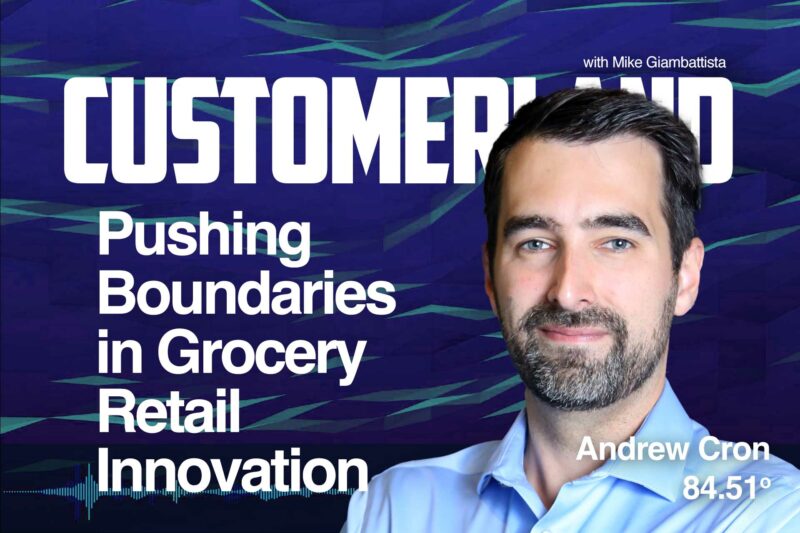Our guest for today’s episode is Andrew Cron, who wears many hats as the Senior Vice President, Chief Scientist, and Head of 84.51o Labs. Taking us on a journey through the various aspects of his role, Andrew delves into the possibilities of innovation at Kroger and 84.51o. We bring to light fascinating discussion points such as retail media networks, last-mile analytics, and even the exciting potential of using video screens to analyze customer sentiment.

We then steer our conversation toward the future of technology in the retail sector. Imagine a world where new technologies and data science transform the retail experience, from dramatically improved customer service to streamlined supply chain operations. Andrew paints a compelling picture of the exciting promise of edge intelligence, collecting and processing data in real time to inform decisions. This episode is a treasure trove of insights into innovation, collaboration and the importance of finding the right partners to push boundaries and make incredible things happen.
This episode of Customerland is sponsored by
Read the full transcript below
Mike Giambattista
Today I’m with Andrew Cron, who is Senior Vice President and Chief Scientist, and Chief Scientist and Head of 84.51o Labs. Andrew, thanks a million for being with me here.
Andrew Cron
I’m happy to be here. I’m excited to chat about innovation at Kroger and 84.51o.
Mike Giambattista
There’s quite a bit to talk about. I mean, first I think I just want to go back and make sure that I have all the components of your title covered, because there’s a lot going on there. Senior Vice President, Chief Scientist, Head of 84.51o Labs. That’s a lot of stuff to cover and to manage and to run.
Andrew Cron
You’re telling me yeah, so my role let’s focus just on Head of Labs. So I lead R&D for 84.51o. So we have a central group that we call 84.51 Labs.
That it’s a really cool job actually we get to look over their horizon and work on those innovation initiatives that are maybe not next year and built into the P&L per se. Of course, we’re still always focused on value and ROI from innovation, but focused on kind of what could be out there next year. So, going after those higher risk, potentially big return initiatives and helping figure out what’s feasible, what’s not, and helping de-risk a little bit, actually, as if all of those titles weren’t enough, but I think it’s relevant for this conversation.
As of earlier this year I also have responsibility for Kroger, for innovation at Kroger as well, for R&D at Kroger Technology, which, when we’re talking about digitizing the store, it’s exciting to be in that world as well, where there’s some more kind of physical innovation as well from like a sensor and video analytics perspective that I think we’ll probably get to.
Mike Giambattista
I’m super excited about this because it hits a handful of my personal hot buttons. Plus, whenever we touch on these kinds of topics with the customer, we get an awful lot of interaction and commentary and people just think about what the possibilities are. So back in January at the NRF conference, one of the big themes then were the advent of advent wrong word but retail media networks and how retailers were deploying were becoming the channels with new technologies enabling CPGs to bridge a never before bridgeable gap between themselves and consumer, which is super interesting and lots of investment and R&Ds. But alongside that, I spoke with a handful of people who were running technologies that were kind of you have a better word for it than I do but kind of last mile analytics. So there’s a company and I’ll think of the name as soon as we hang up, I’m sure who had some really cool ways of doing video analytics.
First stops by a video screen. This technology analyzed their sentiment and, to an extent, their intent, based on how quickly they walked to or from the screen, their facial expressions, and was able to serve up messaging accordingly and guide them towards A, B or C directions. There’s pretty cool stuff and I thought that actually kind of blew me away, because that’s been really difficult to pull off, if not impossible, up until now. But what you’re looking at is stuff that’s not even to market yet.
Andrew Cron
Right, right, or at least not market and grocery retail. I’ll probably clarify. Okay, exactly.
Mike Giambattista
So, without kind of blowing the surprises, as it were, what kinds of things are you looking at? 84.51o Labs that you think maybe market ready at some point may have a value proposition in marketplace.
Andrew Cron
Yeah, oh my gosh, there’s so much, Especially when you’re kind of thinking in store. I think our imaginations often because most of us are customers at a grocery retailer, not, say, working or running one I think our imaginations often go to well, what’s the customer going to see and feel kind of directly from?
either on their phone or screens in the store, and that is coming. And there are things and things already deployed, like cooler screens those aren’t personalized per se, but being able to kind of have customized advertising in the stores, and all that. However, I think maybe not, however, but I’d encourage everyone that’s working in this space to think about the other side, which is the associate experience and how we help the associates meet the customer needs better and more efficiently in real time.
I think that’s actually where the first deployments are going to be, because, if you think about delivering the best possible grocery experience, of course having a screen help you out is great, but having an associate have the time to come personally help you out or have the ensuring that there’s not long lines in the store or that the store is in a pristine condition and will stock to all that. I would argue gives you a better experience than having a screen that will talk to you.
Do I think screens that will talk to you are coming? Yes, however, I think, having advanced analytics and so maybe taking one step back before I say that more and more, each associate has some kind of device in their hands, something like an Android phone, but some kind of proprietary device that ends up being a huge opportunity, because we can feed so much insights about what’s happening in the store right now, what’s happening with the customers right now, to specific associates, whether it’s the manager or someone in the front or someone in the back or someone doing picking to help them do their job more effectively, which it’s not like they’re not already doing a great job, but, of course, everyone’s stretched. So the more effectively they can meet customers the customers’ needs, I think, the more we’ll see that growth for customers. You’re talking about being able to see people’s intentions and all that. I think that is coming.
I think there’s likely lower hanging fruit, for instance, now, of course, the store is a large space to cover, but if we are able to see the entire state of the store from a top-down perspective and see where customers are queuing, maybe, where there’s a mess, where customers are waiting, and notify associates in real time that there’s an issue that they could potentially help address. I think that will sorry, I have to believe I think that will materially that is coming and I think that will materially affect customers’ experience.
One thing I do want to emphasize, though not just with this, but with everything is that treating customers’ data right and ensuring that we have consent and privacy and all those things is extremely important.
We started thinking about doing advanced analytics in the store.
Also, making sure that you are protecting customers’ privacy is extremely important. There’s been a lot of innovation in that space as well. If you think about cameras, one extreme is being able to tell what people are feeling with a look on their face. Another extreme, which is also super important, is to be able to do on the hardware, detect that you’re looking at a face at all and remove it before you potentially send it up to the analytics chain, because you may not want to have everyone’s faces recorded through history. I think one more is, of course, the insights that we will soon be able to give to both CPGs and Kroger itself. I’m just thinking about doing experiments and not just seeing what we see today, which is either surveys or sales data, let’s say, if you put a display in a certain place or change how the assortment is laid out but actually being able to see heat map or hot spots or timing for when customers stop, how long they dwell, will be extremely insightful. That’s far as not trivial to create, especially at scale.
Mike Giambattista
Admittedly, I would be the absolute wrong person to have your job, not only because I’m seriously unqualified for it, but because being in a position where you’re looking at technologies potentially game changing technologies as your job description and what people could be doing with those two, three years out, is literally the definition of how I want to spend my career, but I’d have shiny object syndrome to the point where nothing productive would happen. Having said that, though, you clearly don’t suffer from the same problem when you’re looking at these things the quantity of solutions that you see out there. One I’m just curious to see what’s the most exciting maybe not even from a value or productivity standpoint, I think is the wildest coolest stuff out there, because you probably have a view to that better than most people. Then I’d love to hear layer on the value there. But first, what’s just exciting and cool?
Andrew Cron
I think there are one of them I kind of touched on already, but I think there are two areas in grocery retail that really come to mind. One is specifically in grocery retail, but I probably lose my job if I didn’t mention that the explosion of large language models is really exciting for handedly anyone who has a lot of text that they need to understand, so that I, of course, could be Google or Microsoft, but any corporation or doesn’t have to be a corporation, even that has a huge amount of documentation or feedback or descriptions that they want to be able to understand in a more interactive way. We’re still discovering what these technologies will be able to do reliably and not, but I think the way we as people process huge amounts of text information is going to change significantly. I don’t know if that’s so much a grocery statement as much as I’d say it’s more of a technology statement overall and it’ll be really exciting to see how that unfolds. The other, which I have to be honest, in the retail space, find more exciting. I alluded to this a little bit. The other is to start to have more and more intelligence at the edge. So that’s everything from at this point.
Effectively, everyone has a phone in their pocket. I realize not quite everyone, but the penetration of phones is very high. Associates, more and more have devices in their pockets or somewhere with them. But also, as this technology gets cheaper and cheaper, we will have more and more sensors throughout the stores. You start to think about Internet of Things and starting to get the cost so low that we can understand through the entire supply chain whether or not something is staying cold enough or moving fast enough, or where it’s getting held up, or if there’s potentially less than ideal gases that are near, say, produce at some point that are inhibiting freshness, and it goes on and on and on.
As we’re able to both collect more and more data and it’s not just customer behavior data, but it’s everything throughout the retail experience as we’re able to collect more and more of that, process it in real time and then push it in near real time to the people that need to see it, know about it, understand it, I think we’re going to be able to react at a pace that we’ve just never seen before, and that gets me really excited, partially because I think it’ll be very impactful. But also because it involves so many, it’s not just one innovation right. It requires tens of innovations to create that whole kind of real-time data pipeline, if you will. That, as companies, Kroger Included, start to create these, I think we’re going to see a real jump in how well we’re able to execute.
Sponsor Announcement
I want to take a quick break from the conversation to tell you a story – our story – the story of TheCustomer.
As of the air date for this podcast TheCustomer is officially 4 years old. And if you do the math, that puts our birth date just before the pandemic hit in full. And if you operated in this space at the time, you’ll know that business – at least in our world – came to a screeching halt. And it didn’t really come back to life for another year plus. To say those were difficult months is a giant understatement. They were for a lot of businesses.
But we got lucky.
Right around that same time I was introduced to a person – and his company – that literally transformed this operation and got us on solid footing, on a solid path. I’m happy and proud to say that TheCustomer is now stable and strong. And a lot of that credit goes to a group called Relationshipping Consulting.
Relationshipping is the brainchild of George Weidemann who, if you’re not familiar, is founder, and CEO of one of the largest ad agency conglomerates in the world. His tenure leading the efforts at Time, Inc. and Grey Direct were transformative to say the least and now George and his team are helping organizations across the customer-engagement ecosystem to build healthier businesses and happier shareholders.
I can’t say enough about the effect of those efforts on TheCustomer. Suffice to say – if your business operates in some corner of this big ecosystem, and if you’re looking for a growth partner and strategist, you should really give Relationshipping a shout.
Or reach out to us at TheCustomer and we’ll put you in touch.
Mike Giambattista
So you sort of touched on something. I’m not even sure how to ask it, but because you explore and investigate such a breadth of technologies and opportunities out there and get to decide how to shape and manipulate them in order to bring value to retail and grocery. If you’re looking at it all through the lens of the retail experience, what’s the roadmap there? And that’s not even the right question. But how do you, how do you, as someone who runs 84.51o Labs, think about operationalizing these cool new ideas, these things, because they need to fit into an operations circuit somehow at some point to bring the right value at the right time. And it seems to me that operationalizing these things is probably its own set of really unique and maybe even more difficult challenges. How do you make this kind of plug fit into this kind of plug? That’s basic but, as you just said, it requires tens of technological advancements to make some of this stuff real.
Andrew Cron
Yeah, and that’s a very complicated question, so probably dance around parts of it.
Mike Giambattista
Sorry, I just no. No, it’s a great question.
Andrew Cron
It’s really the crux of what we’re trying to do, right. So one is that, okay, I think there’s let’s call it three things that we have to be balancing all the time. So one is to, of course, in this camp, where we’re talking about so far, is to have due to do our best. It’s very hard because things are moving so fast, but to have a pulse on what is changing right From just from a pure technology perspective, so that we tail aside, excuse me, but, where is data science going?
Where is compute going as sensors so on and so forth, like seeing where that’s going and being ready that.
If you’re an R&D or a lab that just does that, though, I think that you’ll miss the point because you won’t have the impact because you’re not bringing that change management along right.
Deploying anything across thousands of stores and hundreds of thousands of associates and millions of customers is extremely challenging and I’ll make a bold statement and say I don’t think it’s bold, but might sound bold to say you absolutely will not do that in a lab, right, you can get people imagining, dreaming, maybe even proving the concept, proving some economics, showing that a particular innovation could be feasible, but strictly within a lab, without collaboration.
That’s as about as far as you get, which means the other kind of two pillars, in my opinion, of running any successful innovation arm is to have some folks that are tightly integrated with business teams and understanding their problems. So we actually do our best to, whenever it’s feasible, to get ourselves in the shoes. It’s easy to get in the shoes of the customers, because we all obviously go buy groceries, right, but to also get ourselves in the shoes of the associates, whether or not it’s going to look at, visit warehouses and understanding their issues. Or going to pick for a day and understanding the challenges there, going through store walks and seeing what the challenges a manager has, so on and so forth. Really seeing and feeling those challenges is super important so that as we look at what’s coming on the horizon, we have a constant eye to do. These new technologies offer solutions to real problems right.
Because there’s going to be all kinds of technology out there. That’s exciting for somebody, but not for grocery retail, right? So having an eye for what are the big problems that no one’s figured out that would have an impact on a grocer, is huge. And then the other one and this is the third, which is probably the least exciting, but sometimes the most important is doing the nitty gritty of once you said well, man, this is a big problem to solve and we do think something’s feasible.
Is, you know, doing the work of like getting through a business case and saying, look, is this actually viable? Can we scale at cost, or is there actually more innovation to figure out how to even test or get to a whole division scale? Do we have partners to scale? Could we do the change management? That takes much, much more than an R&D group and that’s where we have to do it through collaboration and ultimately you could think of it as even kind of selling to the rest of the business that, hey, we’ve almost kind of planted the seed and shown that, this fusing analogy to show that this plant can grow. But you’ve got to take it and you’ve got to put it in the greenhouse and then in the garden and grow it and we can help. But if the business doesn’t want to take it and scale it then which often happens, by the way then we move on to the next thing and keep going until we find the next big breakthrough.
Mike Giambattista
Well, it is one thing to identify one application that’s going to bring some value to the chain, sequence, stack, whatever you want to call it, and kind of insert that as a singular solution. That’s one thing. I’m sure you probably deal with that frequently. But it’s an entirely different proposition when you’re looking at LLMs and their potential significance and impact on many components of that same chain or stack, and that it seems to me involves, as you’ve said, change management, maybe even cultural change. Absolutely, that goes well beyond just a kind of the exciting shiny object syndrome that I’m so. So is that part of your purview as well? Or are those other components, other groups within Kroger and 84.51o who are charged with kind of vetting and understanding how these bigger initiatives get deployed, or even if yeah.
Andrew Cron
So that’s definitely beyond just R&D. So now we’re really talking. It depends on which thing we’re getting into specifically. That now goes to broader engineering or product leadership, that either 84.51o or Kroger technology. But we of course, on these big novel applications, we have to work together, right? Because you know? So what am I trying to say?
Sometimes it even goes the other way, where you say, hey, we think this technology can solve this problem, but we’re not sure Can R&D help us kind of vet it, prove it, see if it’s feasible, see if it’s real. Or sometimes it goes the other way we have a great idea, we see a problem, we show that it’s potentially feasible and we come to them and say this is what we think. Let’s work together to come up with kind of a plan for how it would scale out. But absolutely, once you’re talking about materially, she will even, even incrementally. But once you’re talking about materially, changing the way such a complicated operation operates, it takes an enormous team and many, many different teams to get through, whether it’s building the technology or going through the change management.
We are just one small piece of that very complicated puzzle and, as I think you’re also implying, it takes a lot of patience. It takes a lot of collaboration, and you know, and often a lot of. We try not to say failures, we refer to them more as pauses. You know, sometimes you’re too early and the business isn’t ready or the technology isn’t ready, right, and we move on. That doesn’t mean that we’ve failed. We’ve learned, we’ve shown that something could be feasible in the future and in fact, we have an initiative right now that we thought was quote dead three years ago and now we’re partnering to scale across the enterprise.
You know it just wasn’t the right time right. So having that patience to pause and kind of pull multiple threads at the same time while you’re waiting for the right time for one of them is it’s an art more than a science, and it’s also a cultural shift that you often have to undertake to get folks to be willing to wait for one opportunity whilst working on another.
Mike Giambattista
Here’s my impression of Kroger I’m on the outside, you’re on the inside, so we’ll talk offline about how poorly I’ve assessed this.
No, but I, Kroger, 84.51o, you are proving fairly consistently that you, as a combined group, are pushing innovation in grocery retail and in my view you’re probably pushing innovation harder and further than almost any other entity, certainly the other entity I can think of in that space. So it seems to me that your culture is probably, currently is probably one of where innovation, where cultural change, is going to be a little bit more feasible than most others. Just because that’s who you are, that’s your DNA as of the past 10 years or so. But when you’re dealing with other entities, it would seem that, whereas this will come out sounding like a question at some point, but for now it’s For now I would think that most other outside organizations would view recommendations as not the right word but kind of a cherry-picker solution. They can’t see the holistic approach that you’re taking to grocery retail and improving the value points along these complex chains, so they’re probably only going to see oh great, they come up with a great solution, let’s see if we can fit that into our organization.
Andrew Cron
I still don’t think there’s an actual question in there, but Maybe I will just say definitely, coming squarely into the 84.51o space, where we have all of our CPG partners as well. I think you’re half right and I obviously won’t name names here, but of course there are some organizations that are more followers than wanting to push the envelope and wanting to see a new innovative offering or capability thoroughly vetted and proven before they sign up.
Sure, however, there are other partners with 84.51o and Kroger that are extremely innovative and, to be honest, sometimes it’s the other way, where, man, they’re banging on my door all the time like when’s the next cool thing coming out? I want to test it. I heard you talk about this. I’m probably going to get it from this call too, right? Like people are going to hear and be like, hey, you were talking to the game about X, when are we going to test it? Right, let’s test it. As any company trying to push that envelope innovation, like you talked about 84.51, it’s critical to find those partners that do want to be on the edge with you, because there are some out there and when you find those partners, you can really go fast and you can do amazing things really quickly. So I don’t know if that answered the question that was behind there, but I think it’s at least important if you’re thinking about how to do innovation through partnerships.
Mike Giambattista
It clarified my murky thinking Still looking for an actual question there, but I think it would be fun to go through the different use cases of and where some of these technologies can be deployed. But I’m almost wondering if that’s not a subsequent conversation, because there’s so much we could talk about it’s entirely up to you.
Andrew Cron
I’m happy to go there, but I feel like this might be a yeah, I think, considering how many we could talk about it, probably it would be better to pick one and drill in deep on another day and we can keep this topic more about how we approach it more holistically and the big opportunities and whatnot.
Mike Giambattista
Yeah, that’s what I’m thinking, and I don’t know how hard it is to get on your schedule, but if that’s something that you’re into, I think whenever it works for you and your team to do a follow up and we can start digging into each one of these, because there’s gold there.













